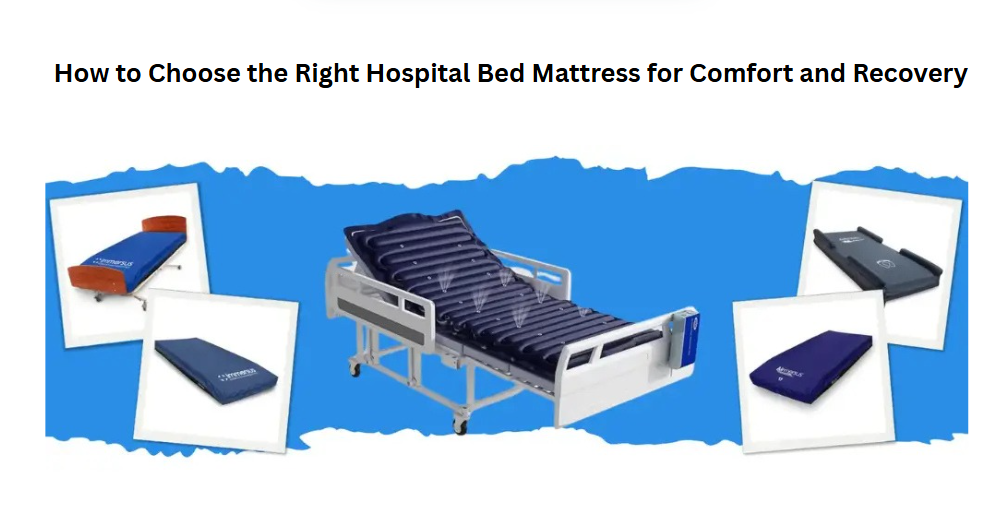A hospital bed is only as good as the mattress it supports. Whether in a medical facility or a home care setting, the hospital bed mattress plays a critical role in ensuring patient comfort, safety, and recovery. From pressure relief to skin integrity, the right mattress can make all the difference in healing outcomes—especially for long-term care patients.
If you’re in the process of choosing a patient bed mattress, it’s important to understand the different types, materials, and features available. This guide will help you make an informed decision for your loved one—or for your patients if you’re a caregiver or medical provider.
Why a Specialized Hospital Bed Mattress Matters
Unlike regular mattresses, hospital bed mattresses are specifically designed to address the needs of patients with mobility issues, chronic conditions, or recovery challenges. They are made with materials that:
- Reduce the risk of pressure sores
- Support proper body alignment
- Improve circulation
- Allow for better hygiene and cleaning
- Work seamlessly with adjustable hospital beds
These features are crucial when you’re dealing with people who spend most of their day lying down. A poor-quality mattress can quickly lead to discomfort, muscle strain, and even serious medical complications like ulcers or infections.
Types of Hospital Bed Mattresses
There is no one-size-fits-all solution when it comes to hospital bed mattresses. Here are the most common types, and how each can support different patient needs:
1. Foam Mattresses
Foam mattresses are among the most affordable and widely used types. High-density foam offers firm support and helps evenly distribute body weight. They’re ideal for patients who are partially mobile or require short-term use.
2. Innerspring Mattresses
These are similar to traditional home mattresses but adapted for hospital bed frames. While they provide basic comfort, they are not always suitable for long-term bed rest or for patients at high risk of developing pressure ulcers.
3. Alternating Pressure Mattresses
These mattresses use air cells that inflate and deflate alternately to relieve pressure on various body parts. They are excellent for patients with a high risk of pressure injuries.
4. Low Air Loss Mattresses
Made to manage skin moisture and provide superior airflow, these are ideal for patients with serious wounds or limited mobility. They help regulate temperature and reduce humidity, which supports wound healing.
5. Gel Overlay Mattresses
These offer an extra layer of cooling comfort and pressure redistribution, making them a good choice for patients who complain about heat or stiffness.
What to Consider Before Buying
Choosing the best hospital bed mattress isn’t just about comfort—it’s about matching the right product with the patient’s specific health needs. Here are the most important factors to consider:
1. Patient’s Condition
- Is the patient at risk of developing bedsores?
- Are they completely immobile or partially mobile?
- Do they suffer from chronic pain, arthritis, or other conditions that require enhanced comfort?
2. Duration of Use
Short-term recovery might only need a basic foam or innerspring mattress. Long-term or permanent conditions often require more advanced support, like low air loss or alternating pressure mattresses.
3. Compatibility with Hospital Bed Frame
Make sure the mattress is the right size and style to fit your bed. Adjustable beds require flexible mattresses that move easily with elevation changes.
4. Ease of Cleaning
Patients in recovery or with limited mobility may require regular cleaning due to spills or incontinence. Look for waterproof covers and antimicrobial materials.
5. Weight Capacity
Standard mattresses typically support 250–350 pounds. For heavier patients, bariatric options are available with reinforced cores and higher durability.
Patient Bed Mattress vs. Standard Mattresses
It might be tempting to use a regular mattress for your home hospital bed setup. But doing so can lead to serious health and safety risks.
A patient bed mattress is engineered for medical support. Unlike regular beds, they are made to flex with adjustable bed frames and reduce pressure points for those who lie down for extended periods. These mattresses are also more hygienic and resistant to bacterial growth.
Ideal for Home Care Settings
If you’re setting up a medical bed at home, selecting the right mattress is even more critical. Home caregivers often face unique challenges—limited space, budget concerns, and the need to balance clinical care with a cozy environment.
This is why many families also choose specialized hospital beds for home. These beds are designed to offer all the benefits of clinical-grade equipment while blending more naturally into a home environment. Pairing such beds with the appropriate mattress can make caregiving significantly easier and more effective.
Maintenance and Longevity
Hospital bed mattresses are an investment in health and safety. With the right care, most quality models can last 5 to 7 years. Here’s how to extend their life:
- Rotate or reposition the mattress periodically (if applicable)
- Clean with mild disinfectant and keep it dry
- Use protective covers to guard against spills and stains
- Inspect air or gel models regularly for leaks
If you notice sagging, reduced support, or increased patient discomfort, it may be time to replace the mattress.








